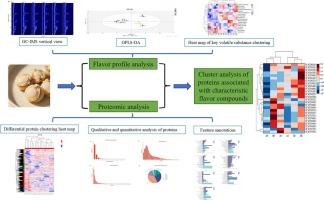Proteomic and flavor dynamics in irradiated scallop adductor muscle during refrigerated storage via 4D-DIA proteomics
IF 9.8
1区 农林科学
Q1 CHEMISTRY, APPLIED
引用次数: 0
Abstract
This study investigated the impact of electron beam irradiation (EBI) on the flavor attributes of scallop adductor muscle during refrigerated storage. Four-dimensional data-independent acquisition (4D-DIA) proteomics and gas chromatography-ion mobility spectrometry (GC-IMS) were utilized to characterize proteomic dynamics and volatile compound profiles. GC-IMS analysis identified 18 significantly altered volatile compounds (VIP > 1, P < 0.05), including aldehydes, ketones, and sulfur-containing derivatives, which collectively delineate irradiation-induced flavor variations. Proteomic profiling revealed 203 flavor-related proteins exhibiting dose- and storage time-dependent expression (P < 0.05), among which 26 proteins were strongly correlated with sulfide production and spoilage odor generation. Gene Ontology (GO) enrichment highlighted dominant biological processes—including amino acid metabolism, lipid/protein oxidative modification, and cellular redox homeostasis—mechanistically linked to flavor compound generation. These findings elucidate the molecular interplay between proteome remodeling and flavor evolution in irradiated seafood, providing protein-level insights for optimizing EBI applications in scallop preservation.


通过4D-DIA蛋白质组学研究辐照扇贝内收肌冷藏期间的蛋白质组学和风味动态
研究了电子束辐照对扇贝冷藏过程中内收肌风味特性的影响。利用四维数据独立采集(4D-DIA)蛋白质组学和气相色谱-离子迁移谱法(GC-IMS)表征蛋白质组动力学和挥发性化合物谱。GC-IMS分析鉴定出18种显著改变的挥发性化合物(VIP >; 1,P <; 0.05),包括醛类、酮类和含硫衍生物,它们共同描述了辐照诱导的风味变化。蛋白质组学分析显示203个风味相关蛋白表现出剂量和储存时间依赖性表达(P <; 0.05),其中26个蛋白与硫化物的产生和腐败气味的产生密切相关。基因本体(GO)富集强调了主要的生物过程,包括氨基酸代谢、脂质/蛋白质氧化修饰和细胞氧化还原稳态,这些过程与风味化合物的产生有机制联系。这些发现阐明了辐照海产品中蛋白质组重塑和风味进化之间的分子相互作用,为优化EBI在扇贝保存中的应用提供了蛋白质水平的见解。
本文章由计算机程序翻译,如有差异,请以英文原文为准。
求助全文
约1分钟内获得全文
求助全文
来源期刊

Food Chemistry
工程技术-食品科技
CiteScore
16.30
自引率
10.20%
发文量
3130
审稿时长
122 days
期刊介绍:
Food Chemistry publishes original research papers dealing with the advancement of the chemistry and biochemistry of foods or the analytical methods/ approach used. All papers should focus on the novelty of the research carried out.
 求助内容:
求助内容: 应助结果提醒方式:
应助结果提醒方式:


